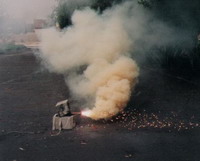Chinese cloud-seeding program sounds controversial
China plans to shield this summer's Olympics from rainy weather. The state is going to send a couple of rockets to seed clouds and produce rain just days before the games.

The Chinese weather modification office rarely publishes in the open scientific literature and therefore their claims of success are widely disputed.
On the whole scientists remain skeptical about such manipulations with weather.
Scientists have been trying to change weather since the mid-1940s. During the Vietnam War, the U.S. military tried to swamp the Ho Chi Minh Trail by producing torrential rains. But military use of weather modification has since been banned by an international treaty.
China 's plans for the Olympic games reveal just a small part of this global modification program. Large investments from the United States , sufficient number of people, rockets and anti-aircraft guns will help seed clouds to induce rainfall for the country's parched northern region.
In spite of the popularity this project attracts worldwide, there is still no agreement on its benefits.
While cloud seeding has shown to be effective in altering cloud structure and size, and converting cloud water to ice particles, it is more controversial whether cloud seeding increases the amount of precipitation at the ground.
Part of the problem is that it is difficult to discern how much precipitation would have occurred had the cloud not been "seeded." In other words, it is hard to discern additional precipitation from seeding from the natural precipitation variability, which is frequently much greater in magnitude.
Nevertheless, there is more credible scientific evidence for the effectiveness of winter cloud seeding over mountains (to produce snow) than there is for seeding warm-season cumuli form (convective) clouds. This statement is supported by the professional societies Weather Modification Association, World Meteorological Organization, and American Meteorological Society (AMS). The AMS further states that there is statistical evidence for seasonal precipitation increases of about 10% with winter seeding.
The National Center for Atmospheric Research (NCAR), an institution in Boulder , Colorado , has made some statistical analysis of seeded and unseeded clouds in an attempt to understand the differences between them. They have conducted seeding research in several countries that include Mali, Saudi Arabia, Mexico, South Africa, Thailand, Italy, and Argentina.
Photo: www.atmos-inc.com
Subscribe to Pravda.Ru Telegram channel, Facebook, RSS!


